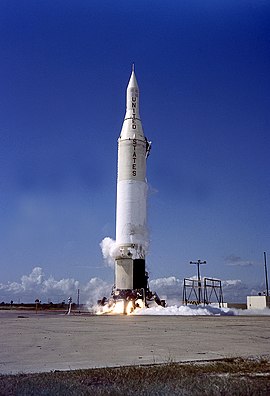Juno II

Launch of a Juno II
|
|
| Function | Expendable launch system |
|---|---|
| Manufacturer | Chrysler for the ABMA |
| Country of origin | United States |
| Cost per launch | US$10.83m (1985) |
| Size | |
| Height | 24.0m (78.7ft) |
| Diameter | 2.67m (8.76ft) |
| Mass | 55,110kg (121,500lb) |
| Stages | 3-4 |
| Capacity | |
| Payload to LEO | 41kg (90lb) |
| Payload to Sub-orbital TLI | 6kg (13lb) |
| Associated rockets | |
| Family | Jupiter |
| Launch history | |
| Status | Retired |
| Launch sites | LC-5 & LC-26B, CCAFS |
| Total launches | 10 |
| Successes | 4 |
| Failures | 5 |
| Partial failures | 1 |
| First flight | 1958-12-06 |
| Last flight | 1961-05-24 |
| Notable payloads | See text |
Juno II was an American space launch vehicle used during the late 1950s and early 1960s. It was derived from the Jupiter missile, which was used as the first stage.
Solid rocket motors derived from the MGM-29 Sergeant were used as upper stages—eleven for the second stage, three for the third stage, and one for the fourth stage—the same configuration as used for the upper stages of the smaller Juno I rocket. On some launches to low Earth orbit the fourth stage was not flown, allowing the rocket to carry an additional nine kilograms of payload. Development of the Juno II was extremely fast due to being completely built from existing hardware. The project began in early 1958 and the first vehicle flew at the end of the year. Chrysler were responsible for the overall contract, while Rocketdyne handled the first stage propulsion and Jet Propulsion Laboratory handled the upper stage propulsion. The first three were converted Jupiter missiles, however all remaining boosters were built as Juno IIs from the beginning.
The main differences between the Juno II and Jupiter were stretched propellant tanks for increased burn time (the first stage burn time was approximately 20 seconds longer than on the Jupiter), a reinforced structure to support the added weight of upper stages, and the inertial guidance system replaced with a radio ground guidance package, which was moved to the upper stages.
The Juno II was used for ten satellite launches, of which six failed. It launched Pioneer 3, Pioneer 4, Explorer 7, Explorer 8, and Explorer 11 from Cape Canaveral Launch Complex 5 and Launch Complex 26B.
The first launch of a Juno II, Pioneer 3 on December 12, 1958, suffered a premature first stage cutoff, preventing the upper stages from achieving sufficient velocity. Pioneer 3 could not escape Earth orbit, but transmitted data for some 40 hours before reentering the atmosphere. A malfunction in a propellant depletion circuit was found to be the cause of the failure, although the exact nature of it could not be determined. The circuit was redesigned afterwards.
...
Wikipedia
